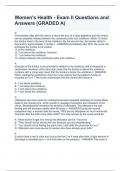-
1. Exam (elaborations) - Women's health questions with verified answers
-
2. Exam (elaborations) - Women's health questions and answers(rated a+)
-
3. Exam (elaborations) - Women's health questions with complete solutions!!
-
4. Exam (elaborations) - Women's health exam 1 questions and answers 100% accurate
-
5. Exam (elaborations) - Women's health exam 1 questions and answers(graded a+)
-
6. Exam (elaborations) - Women's health issues:module questions & answers(100% verified)
-
7. Exam (elaborations) - Women's health chapters 1-3 exam questions & answers(scored a+)
-
8. Exam (elaborations) - Fnp: women's health exam questions and questions latest update
-
9. Exam (elaborations) - Np women's health exam questions and answers (graded a+)
-
10. Exam (elaborations) - Women's health 220: exam 1 exam questions and answers(rated a)
-
11. Exam (elaborations) - 620 adult - women's health - ag and fnp certification exam 4th ed. winland-brown and ...
-
12. Exam (elaborations) - Eor exam women's health questions & answers 100% correct
-
13. Exam (elaborations) - Exam 1 womens health ch 1-5 questions and correct answers with rationales / a grade
-
14. Exam (elaborations) - Womens health exam questions with correct answers
-
15. Exam (elaborations) - Women's health practice quiz 100% accurate answers
-
16. Exam (elaborations) - Women's health/ob test 1 complete questions & answers (100% accurate)
-
17. Exam (elaborations) - Hlth 334 (women's health)- exam 1 questions with verified answers
-
18. Exam (elaborations) - Women's health primary care (100 questions) with correct
-
19. Exam (elaborations) - Chapter 1 - 3 women health exam q & a verified /updated 2024
-
20. Exam (elaborations) - Women's health qbank exam compilation verified / guaranteed
-
21. Exam (elaborations) - Women's health chapter 1 exam questions & answers(rated a)
-
22. Exam (elaborations) - Ch 1 - intro to women's health exam questions and answer 100% correct
-
23. Exam (elaborations) - Womens health test 1 exam questions with complete solutions!!
-
24. Exam (elaborations) - Women's health - exam ii questions and answers (graded a)
-
25. Exam (elaborations) - Women's health exam 1 questions with correct answers
-
26. Exam (elaborations) - Nsg6020- women's health test review with complete solutions!!
-
27. Exam (elaborations) - Nsg6020- women's health test review with complete solutions!!
-
28. Exam (elaborations) - Women's health ch. 1- ch.8 exam questions and answers(scored a+)
-
29. Exam (elaborations) - Chapter 9-women's health exam questions and answers(rated a+)
-
30. Exam (elaborations) - Ncc women's health exam questions and answers (scored a)
-
31. Exam (elaborations) - Global health - women's health exam questions and answers
-
32. Exam (elaborations) - Ob - women's health test review questions and answers(graded a+)
-
33. Exam (elaborations) - Women's health issues final exam questions and answers 100%correctwomen's health issu...
-
34. Exam (elaborations) - Women's health: menopause exam questions & answers(graded a+)
-
35. Exam (elaborations) - Advanced women's health final exam questions and answers 100% solved
-
36. Exam (elaborations) - Women's health in primary care exam questions with answers 100%accurate
-
37. Exam (elaborations) - Women's health exam 3 test bank exam with 100% verified answers
-
38. Exam (elaborations) - Women's health final study guide exam questions & answers(rated a+)
-
39. Exam (elaborations) - Women's health final exam chapter 1-16 questions with correct answers
-
40. Exam (elaborations) - Women's health exam # 1 practice questions with latest update
-
41. Exam (elaborations) - Community 17 - women's health exam questions & answers (verified by experts)
-
42. Exam (elaborations) - Maternity and women's health- exam 1 questions and answers
-
43. Exam (elaborations) - Women's health - uworld questions with complete solutions!!
-
44. Exam (elaborations) - Women's health – review questions with latest solution!
-
45. Exam (elaborations) - Women's health study questions with answers graded a+
-
46. Exam (elaborations) - Sherpath ch 17 - women's health exam questions and answers 100% accuratesherpath ch 1...
-
47. Exam (elaborations) - Pelvic health and women's health: overview questions with all answers correct
-
48. Exam (elaborations) - Exam 1: women's health issues uf with answers guaranteed pass 2023/ 2024
-
49. Exam (elaborations) - Foundations of women's health exam questions and answers 100%correct
-
50. Exam (elaborations) - Nursing application: women's health medications exam questions and answers
-
51. Exam (elaborations) - Twu-women's health exam questions with verified answers
-
Show more




